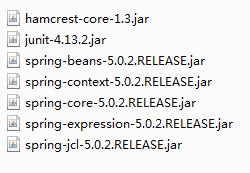Spring第一课 Spring框架的环境搭建和使用
Posted 笔触狂放
tags:
篇首语:本文由小常识网(cha138.com)小编为大家整理,主要介绍了Spring第一课 Spring框架的环境搭建和使用相关的知识,希望对你有一定的参考价值。
概念
Spring框架是由于软件开发的复杂性而创建的。Spring使用的是基本的JavaBean来完成以前只可能由EJB完成的事情。然而,Spring的用途不仅仅限于服务器端的开发。从简单性、可测试性和松耦合性角度而言,绝大部分Java应用都可以从Spring中受益。
Spring的初衷:
1、JAVA EE开发应该更加简单。
2、使用接口而不是使用类,是更好的编程习惯。Spring将使用接口的复杂度几乎降低到了零。
3、为JavaBean提供了一个更好的应用配置框架。
4、更多地强调面向对象的设计,而不是现行的技术如JAVA EE。
5、尽量减少不必要的异常捕捉。
6、使应用程序更加容易测试。
Spring的目标:
1、可以令人方便愉快的使用Spring。
2、应用程序代码并不依赖于Spring APIs。
3、Spring不和现有的解决方案竞争,而是致力于将它们融合在一起。
Spring的基本组成:
1、最完善的轻量级核心框架。
2、通用的事务管理抽象层。
3、JDBC抽象层。
4、集成了Toplink, Hibernate, JDO, and iBATIS SQL Maps。
5、AOP功能。
6、灵活的MVC Web应用框架。
1.项目环境搭建
打开idea开发软件,新建web application项目,在WEB-INF下新建lib文件夹,将以下jar包导入其中

这些jar包中用于Spring框架的使用和JUnit的单元测试。
将Spring框架的主配置文件导入resources资源文件夹中,并转换成项目的资源文件夹

如果该过程未掌握的初学者,请先阅读【MyBatis】第一课 MyBatis的框架的搭建和使用
该文中有详细的步骤进行关联jar以及转换资源文件夹。
2.创建实体类以及测试类
在src文件夹中,创建com.spring.entity和com.spring.test包,分别在包中创建Student实体类和SpringTest测试类。
其Student.java中代码如下:
package com.spring.entity;
import java.util.Date;
public class Student
private String name;
private int age;
private Date birthday;
public Student()
public Student(String name, int age, Date birthday)
this.name = name;
this.age = age;
this.birthday = birthday;
public Date getBirthday()
return birthday;
public void setBirthday(Date birthday)
this.birthday = birthday;
public String getName()
return name;
public void setName(String name)
this.name = name;
public int getAge()
return age;
public void setAge(int age)
this.age = age;
在SpringTest类中创建测试类方法,通过java代码方式创建对象以及Spring框架方式创建对象进行对比。
java代码创建对象以及赋值全局变量的方式:
@Test
public void one()
//java的面向对象
Student student1=new Student();
student1.setName("小明");
student1.setAge(20);
System.out.println(student1);
System.out.println(student1.getName()+"--"+student1.getAge());
Spring框架使用xml方式创建对象,在ApplicationContext.xml主配置文件中,创建对象:
<?xml version="1.0" encoding="UTF-8"?>
<beans xmlns="http://www.springframework.org/schema/beans"
xmlns:xsi="http://www.w3.org/2001/XMLSchema-instance"
xsi:schemaLocation="http://www.springframework.org/schema/beans
http://www.springframework.org/schema/beans/spring-beans-4.0.xsd">
<!--Student student1=new Student();-->
<!--scope=""用于设置当前对象在被创建的时候,使用一个对象还是多个对象
singleton:创建多个对象的时候,只使用一个对象 单例模式 默认为单例模式
prototype:创建多个对象 多例模式-->
<bean id="stu" class="com.spring.entity.Student" >
<property name="name" value="小王"></property>
<property name="age" value="22"></property>
</bean>
</beans>接着在测试类中定义方法进行获得主配置文件中创建的对象:
//使用Spring框架的方式将对象写入了xml文件中
//首先需要加载Spring框架的主配置文件
ApplicationContext ac=new ClassPathXmlApplicationContext("applicationContext.xml");
//Spring框架创建多个对象,默认是单例模式,只有一个对象。
Student stu=(Student) ac.getBean("stu");
System.out.println(stu);
System.out.println(stu.getName()+"--"+stu.getAge());那么如果全局变量中包含引用数据类型的实体类变量,那么需要进行单独创建出来,然后使用ref属性进行关联。
@Test
public void two()
//java代码方式
Student student=new Student();
student.setName("徐树华");
student.setAge(17);
Date date=new Date();
date.setYear(120);
date.setMonth(12);
date.setDate(20);
System.out.println(date);
student.setBirthday(date);
而使用Spring框架方式需要在ApplicationContext.xml文件中:
<bean id="stu" class="com.spring.entity.Student" >
<property name="name" value="小王"></property>
<property name="age" value="22"></property>
<property name="birthday" ref="date"></property>
</bean>
<!--Date date=new Date();-->
<bean id="date" class="java.util.Date">
<property name="year" value="121"></property>
<property name="month" value="3"></property>
<property name="date" value="28"></property>
</bean>并使用测试方法进行获得:
//Spring框架方式
ApplicationContext ac=new ClassPathXmlApplicationContext("applicationContext.xml");
Student student1=ac.getBean("stu",Student.class);
System.out.println(student1.getName()+"--"+student1.getAge()+"--"+student1.getBirthday());3.通过构造方法赋值全局变量
java代码方式同构构造方法进行赋值:
@Test
public void five()
Date birthday=new Date();
Student student=new Student("小明",20,birthday);
System.out.println(student.getName()+"--"+student.getAge()+"--"+student.getBirthday());
Spring框架的主配置文件中赋值:
<!--Date birthday=new Date();-->
<bean id="birthday" class="java.util.Date"></bean>
<!--Student student=new Student("小明",20,birthday);-->
<bean id="ss" class="com.spring.entity.Student">
<!--等价于构造方法的写法
constructor-arg:该标签表示构造方法
type:该属性表示根据变量的数据类型进行赋值(不建议使用,当类中出现多个相同数据类型的变量,不利于区分变量)
index:该属性表示根据构造方法中参数的下标来赋值
name:该属性表示根据全局变量名称来赋值,常用这种方式来进行赋值
value:用于给基本数据类型赋值
ref:用于给引用数据类型赋值
-->
<constructor-arg type="java.lang.String" value="小王"></constructor-arg>
<constructor-arg index="1" value="20"></constructor-arg>
<constructor-arg name="birthday" ref="birthday"></constructor-arg>
</bean>在测试方法中获得:
ApplicationContext ac=new ClassPathXmlApplicationContext("applicationContext.xml");
Student ss=ac.getBean("ss",Student.class);
System.out.println(ss.getName()+"@@"+ss.getAge()+"@@"+ss.getBirthday());4.间接创建对象的方式
定义一个School类,中通过方法创建Student类的对象,其中一个是成员方法,一个是静态方法
package com.spring.entity;
public class School
public Student getStudent()
return new Student();
public static Student getStudent1()
return new Student();
在测试类中测试获得对象:
@Test
public void three()
//获得成员方式
School school=new School();
Student student = school.getStudent();
System.out.println(student);
ApplicationContext ac=new ClassPathXmlApplicationContext("applicationContext.xml");
Student student1=ac.getBean("student",Student.class);
System.out.println(student1.getName()+"--"+student1.getAge());
@Test
public void four()
//获得静态方法
Student student = School.getStudent1();
ApplicationContext ac=new ClassPathXmlApplicationContext("applicationContext.xml");
Student student1=ac.getBean("s",Student.class);
System.out.println(student1.getName()+"--"+student1.getAge());
使用Spring框架中通过调用成员方法和静态方法获得Student对象
<!--第二种间接获得对象的方式-->
<!--School school=new School();-->
<bean id="school" class="com.spring.entity.School"></bean>
<!--Student student = school.getStudent();-->
<bean id="student" factory-bean="school" factory-method="getStudent">
<property name="name" value="马云"></property>
<property name="age" value="50"></property>
</bean>
<!--第三种间接获得对象的方式-->
<!-- Student s = School.getStudent1();-->
<bean id="s" class="com.spring.entity.School" factory-method="getStudent1">
<property name="name" value="任正非"></property>
<property name="age" value="80"></property>
</bean>5.通过Spring框架给数组,集合,Map集合进行赋值
创建一个实体类,定义各种存储大量数据的数组,集合类型的全局变量
package com.spring.entity;
import java.util.List;
import java.util.Map;
import java.util.Properties;
import java.util.Set;
public class Car
private String[] types;//汽车的品牌,宝马,奔驰,奥迪。。。
private List<Integer> prices;//汽车的价格: 100万 10万
private Map<String,String> colors;//汽车的颜色
private Set<String> utils;//交通工具: 自行车,货车,火车,飞机
private Properties properties;
public String[] getTypes()
return types;
public void setTypes(String[] types)
this.types = types;
public List<Integer> getPrices()
return prices;
public void setPrices(List<Integer> prices)
this.prices = prices;
public Map<String, String> getColors()
return colors;
public void setColors(Map<String, String> colors)
this.colors = colors;
public Set<String> getUtils()
return utils;
public void setUtils(Set<String> utils)
this.utils = utils;
public Properties getProperties()
return properties;
public void setProperties(Properties properties)
this.properties = properties;
使用java代码方式对这些全局变量赋值的代码如下:
@Test
public void six()
Car car=new Car();
String[] strs="劳斯莱斯","红旗","比亚迪";
car.setTypes(strs);
System.out.println(Arrays.toString(car.getTypes()));
List<Integer> ps=new ArrayList<>();
ps.add(100);
ps.add(20);
ps.add(50);
car.setPrices(ps);
car.getPrices().forEach(price-> System.out.println(price));
Map<String,String> m=new HashMap<>();
m.put("red","红色");
m.put("yellow","黄色");
m.put("blue","蓝色");
car.setColors(m);
car.getColors().forEach((k,v)-> System.out.println(k+":"+v));
Set<String> set=new HashSet<>();
set.add("自行车");
set.add("火车");
set.add("飞机");
car.setUtils(set);
car.getUtils().forEach(s-> System.out.println(s));
//存储连接数据库的四个参数
Properties properties=new Properties();
//驱动程序
properties.setProperty("Driver","com.mysql.cj.jdbc.Driver");
//访问数据库的地址
properties.setProperty("url","jdbc:mysql://localhost:3306/car");
//登录数据库的用户名
properties.setProperty("username","root");
//登录数据库的密码
properties.setProperty("password","123456");
car.setProperties(properties);
car.getProperties().forEach((k,v)-> System.out.println(k+":"+v));
使用Spring框架的方式,主配置文件中:
<!--Car car=new Car();-->
<bean id="car" class="com.spring.entity.Car">
<property name="types">
<array>
<value>宝马</value>
<value>奔驰</value>
<value>奥迪</value>
</array>
</property>
<property name="prices">
<list>
<value>40</value>
<value>60</value>
<value>80</value>
</list>
</property>
<property name="utils">
<set>
<value>货车</value>
<value>拖拉机</value>
<value>火箭</value>
</set>
</property>
<property name="colors">
<map>
<entry key="white" value="白色"></entry>
<entry key="black" value="黑色"></entry>
<entry key="pink" value="粉色"></entry>
</map>
</property>
<property name="properties">
<props>
<prop key="Driver">com.mysql.cj.jdbc.Driver</prop>
<prop key="url">jdbc:mysql://localhost:3306/car</prop>
<prop key="username">root</prop>
<prop key="password">123456</prop>
</props>
</property>
</bean>在测试方法中测试的运行代码如下:
ApplicationContext ac=new ClassPathXmlApplicationContext("applicationContext.xml");
Car car1 = ac.getBean("car", Car.class);
System.out.println(Arrays.toString(car1.getTypes()));
car1.getPrices().forEach(p-> System.out.println(p));
car1.getColors().forEach((k,v)-> System.out.println(k+"!"+v));
car1.getUtils().forEach(s-> System.out.println(s));
car1.getProperties().forEach((k,v)-> System.out.println(k+":"+v));6.使用Spring框架建立类的生命周期
定义一个类,在类中建立需要执行的几个方法
package com.spring.entity;
public class Dog
public Dog()
System.out.println("创建对象");
//用于初始化数据的方法
public void init()
System.out.println("小狗出生了");
//用于正在运行
public void service()
System.out.println("小狗正在一天天长大");
//销毁当前对象
public void destroy()
System.out.println("小狗生命走到了终点");
在xml主配置文件中:
<!--指定某个类在创建对象的时候,先执行什么,后执行什么-->
<bean id="dog" class="com.spring.entity.Dog"
init-method="init" destroy-method="destroy"></bean>单元测试的方法中执行代码:
@Test
public void seven()
ApplicationContext ac=new ClassPathXmlApplicationContext("applicationContext.xml");
Dog dog = ac.getBean("dog", Dog.class);
dog.service();
//任务处理完了,需要关闭,释放所有对象的内存
((ClassPathXmlApplicationContext) ac).close();
通过运行可以观察到dog对象已被创建就执行了构造方法和init方法,在主配置文件关闭的时候执行了destroy方法。
总结
Spring框架是java学习过程中以及java开发中起到至关重要的框架,它是SpringBoot,以及分布式的学习的奠定基础。本文中只是对Spring框架的初步认识,九牛一毛而已,希望读者可以通过本文打开Spring框架的大门,《一入Java门,从此定是Java人》!!!
以上是关于Spring第一课 Spring框架的环境搭建和使用的主要内容,如果未能解决你的问题,请参考以下文章